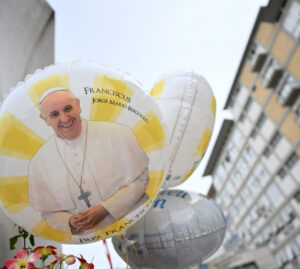Since Feb. 14, 2025, Pope Francis has been hospitalized at Gemelli Hospital in Rome.
Elected in 2013 and 88 years old, Pope Francis’ health appears to be deteriorating. The reports have stated that he is sick with lung disease, double pneumonia and has had events of coughing fits. Over the past weekend, he had to be on supported oxygen, but the Mar. 16 update states that he remained stable, but not out of the danger zone.
For those who have not followed the situation, here are some important details that have been released:
On Feb. 14, the Pope is hospitalized with a complex respiratory tract infection & pneumonia.
On Feb. 22, the Pope experienced prolonged respiratory crisis, and he required high flow oxygen and blood transfusions.
On Feb. 23, he went into onset of slight kidney failure.
On Mar. 6, the Pope recorded an audio message thanking the people for their prayers that was broadcasted in St Peter’s Square.
On Mar. 16, the first photo since hospitalization was released, showing that the Pope was breathing on his own while also receiving oxygen.
On Mar. 17, the Pope’s condition is stable and continuing to improve.
On Mar. 19, his condition has continued to improve, he is recovering from double pneumonia.
Despite Pope Francis’s condition getting better by the day, one thought that may cross people’s minds is what will happen if he dies? The death of the Pope will begin a series of events that has been refined over hundreds of years.
According to tradition, the Camerlengo, which is a senior Vatican official, will confirm the death. The current Camerlengo position is held by Cardinal Kevin Farrell.
Doctors will also aid in confirming with standard medical means. Before a statement is released to the media, the Camerlengo will inform the College of Cardinals, which is a governing body of senior church officials.
After these steps are taken, it will trigger the mourning period. There will be nine days of mourning that is known as the Novendiale, which was originally an Ancient Roman custom. Italy will also declare a period of national mourning.
The Pope’s body will be blessed and dressed in Papal vestments. These are the special liturgical garments worn by the Pope, which includes the mitre, pallium, fanon and the chasuble.
The body will then be exhibited in St Peter’s Basilica for public viewing. Hundreds of thousands will line up to pay their respects, including foreign dignitaries and world leaders. Daily prayer services and Requiem Masses will be held at St. Peter’s Basilica and thorough the Catholic world.
Between four to six days after the Pope’s death, his funeral will be held at St. Peter’s Square, led by the dean of the College of Cardinals, which is currently Giovanni Battista Re.
While this is all happening, the Vatican will enter a transitional period titled Sede Vacante, meaning “the seat is vacant.” For the time being, the rule of the church will be handed over to the College of Cardinals. No major decisions will be made until a new Pope is elected.
This election process will begin two to three weeks after the Pope’s funeral, when the College of Cardinals will convene in the Sistine Chapel. This will be a highly secretive process. The entirety can take hours to months, or even longer.
The next Pope will take over Francis’ role, most likely serve until the day they die. They will wield significant diplomatic and political power, as well as act as a mediator in global conflicts and guide humanitarian efforts.
